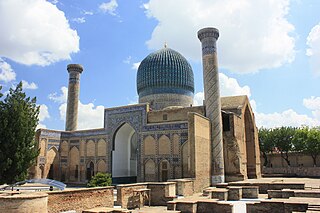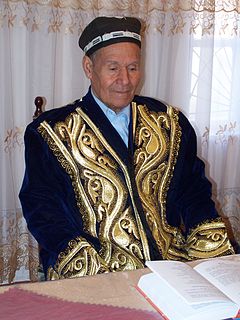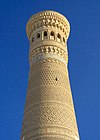This article may be in need of reorganization to comply with Wikipedia's layout guidelines .(April 2016) (Learn how and when to remove this template message) |
Museum of Abu Ali Ibn Sino in Afshona village of Peshku district of Bukhara region was formed in connection with the 1000th anniversary of the great thinker.
The building was small; the halls incorporating with each other were not comfortable for demonstration of exhibits and the museum’s activities. In the years of independence, the building was reconstructed and re-equipped taking into account all condition necessary for a museum. In November 2006, solemn opening ceremony of the updated museum of Abu Ali Ibn Sino, [1] equipped on modern museum standards took place. At the same time, according to the plan for development of Peshku district of Bukhara region [2] a medical college, information-resource center, library, polyclinic, hotel and a teahouse started to operate. [3]
The museum has following sections “The Age of Ibn Sino”, “Contemporaries of Ibn Sino”, “The life and work of Ibn Sino”, “Activity of Ibn Sino in the Academy of Ma’mun”, “Scientific heritage of ibn Sino”, “Legacy of ibn Sino and Modern Science”, “Ibn Sino and modern medicine”. More than 700 exhibits disposed on the podium lead away the visitors to the era of medieval Maverannahr. Among interesting artifacts found in the ancient buildings of Bukhara region there are ceramic subjects, coins and jewelry of the 9th and 10th centuries. Special interest of visitors is called by a breadboard model of an ancient drugstore of the 7th century which was found out during excavation on site of ancient settlement Paykand. [4]
| Wikimedia Commons has media related to Gur-e Amir . |
Considering the samples of medical instruments made of brass used in days of Ibn Sino, one can convince that the majority of them are comparable and similar to tools of modern medicine. The museum [5] displays miniatures created by the scientist, copies of manuscripts, pages from the Arabic manuscript “al-Qonun fi-t-tib” (“Medicine Canons”), copied in 851/1447-48 by Mahmoud al-Mutatabbib, a translation of “Medicine Canons” made in the 14th century by Sheran and Cremon, and other interesting exhibits. [6]
It has become a tradition to organize at the museum monthly interactive seminar-excursions on biology, history, chemistry, zoology and literature for students of different ages in conjunction with mahalla citizens and teaсhers of schools, lyceums and colleges. Students of Bukhara higher educational institutions conduct practical training in the museum.
They take an active part in the “Avicenna Readings” and other events organized by the Public Fund “Ibn Sino – Avicenna”, Institute of Oriental Studies of the Academy of Sciences of the Republic of Uzbekistan and other organizations. [7] [8]
That to such activities the significance of the monument-museum increases.
Biology is the natural science that studies life and living organisms, including their physical structure, chemical processes, molecular interactions, physiological mechanisms, development and evolution. Despite the complexity of the science, there are certain unifying concepts that consolidate it into a single, coherent field. Biology recognizes the cell as the basic unit of life, genes as the basic unit of heredity, and evolution as the engine that propels the creation and extinction of species. Living organisms are open systems that survive by transforming energy and decreasing their local entropy to maintain a stable and vital condition defined as homeostasis.

History is the study of the past as it is described in written documents. Events occurring before written record are considered prehistory. It is an umbrella term that relates to past events as well as the memory, discovery, collection, organization, presentation, and interpretation of information about these events. Scholars who write about history are called historians.
Chemistry is the scientific discipline involved with elements and compounds composed of atoms, molecules and ions: their composition, structure, properties, behavior and the changes they undergo during a reaction with other substances.











